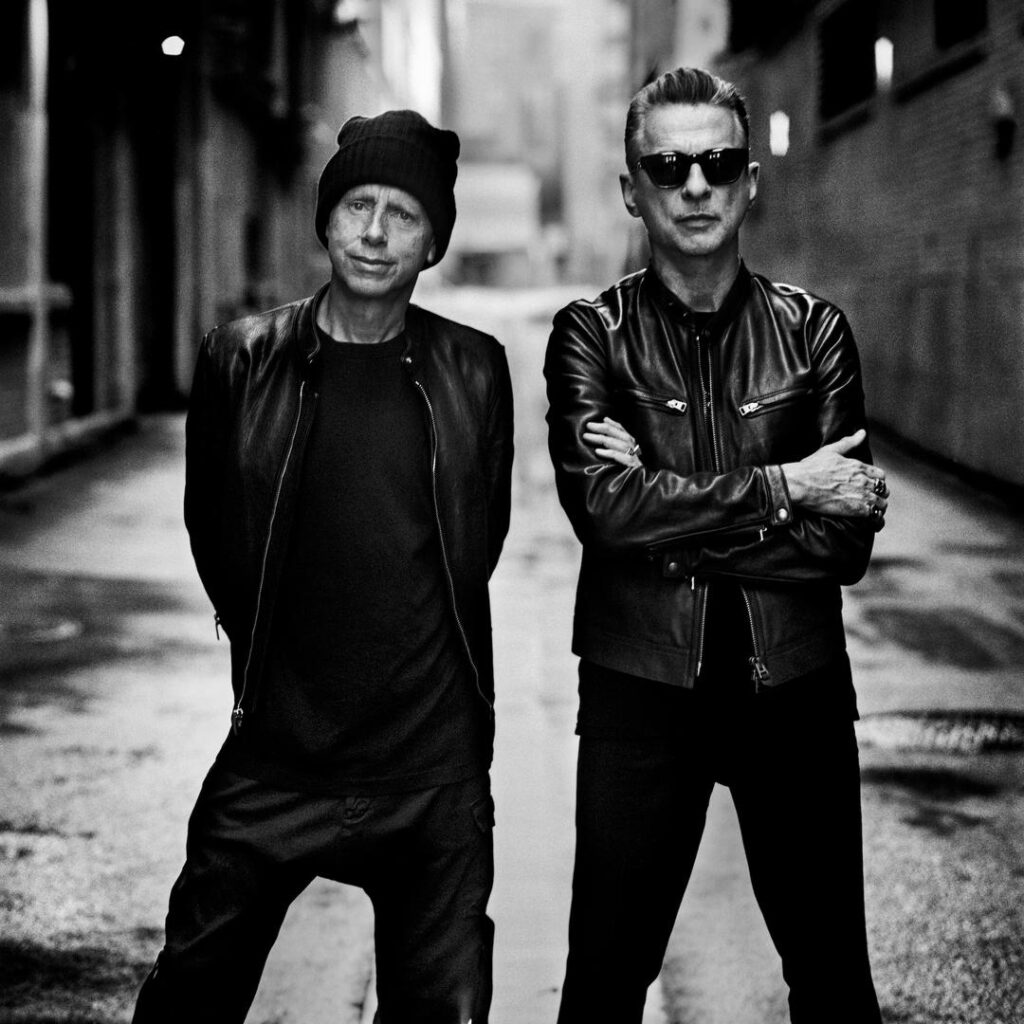
Depeche Mode, the iconic British electronic music band that has defined the sound of synth-pop for over four decades, is back in the spotlight with the release of their latest album, shrouded in mystery and intrigue. The album, which was dropped unexpectedly with little fanfare, has caused a wave of excitement among fans and critics alike—not only for its captivating sound but also due to the enigmatic nature of its content. The most striking revelation comes from the album’s lyric sheet, where observant fans have discovered hidden messages, symbols, and references that have sparked wild theories and speculation about the band’s intentions and the album’s deeper meaning.
For a group that has always been known for their enigmatic approach to music, visual aesthetics, and lyrical content, Depeche Mode’s latest project takes their characteristic mystique to new heights. Fans are now embarking on a thrilling journey of decoding the cryptic clues embedded within the album’s packaging and lyrics. As the band prepares to launch an extensive tour in support of the record, many are wondering: what is Depeche Mode trying to tell us with these hidden messages, and how does it fit into the band’s overall legacy?
In this article, we will explore the mysterious new album by Depeche Mode, uncover the fan theories surrounding the hidden messages, and delve into the possible meanings behind the band’s cryptic approach. Is this album an artistic statement, a political commentary, or something even more personal? Let’s take a deeper look at the clues and what they might reveal about one of the most influential bands in electronic music history.
Depeche Mode: A Band Known for Its Mystery
Depeche Mode has long been a band associated with both innovation and secrecy. From their early days in the 1980s, when they first introduced the world to their distinct electronic pop sound, to their more recent ventures into darker, industrial, and experimental territories, the band has always managed to maintain an air of mystery. Their lyrics, often laced with layers of meaning and complex imagery, have prompted fans to dive deeper into the nuances of their music.
One of the most notable examples of Depeche Mode’s enigmatic approach is their 1990 album Violator, which included the hit singles “Enjoy the Silence” and “Personal Jesus”. The album’s lyrics were open to interpretation, with themes of love, addiction, spirituality, and isolation explored in complex ways. Over the years, fans have come to expect the unexpected from Depeche Mode—an aesthetic that balances between the personal and the political, the sensual and the spiritual, with an undertone of melancholy and reflection.
With the release of their newest album, fans were once again confronted with a sense of mystery. The album dropped with minimal promotional material, and very little was known about the direction the band was taking. What was clear, however, was that Depeche Mode was continuing to explore new sonic landscapes while staying true to their dark, atmospheric style. But it was the discovery of hidden messages in the lyric sheet that truly set the internet ablaze.
The Hidden Messages in the Lyric Sheet
Depeche Mode has always used their album artwork, music videos, and live performances to convey complex emotions and ideas. However, their latest album has taken this concept to a new level, with fans quickly uncovering that the lyric sheet is filled with cryptic symbols, phrases, and hidden messages that don’t appear to be part of the official lyrics.
At first glance, the lyric sheet seems like any other—printed text with the album’s song titles and accompanying lyrics. But fans who closely examined the text began to notice odd patterns: certain words were bolded or underlined, seemingly at random. Some sections of lyrics contained strange gaps or characters that appeared to be intentionally out of place. As the analysis deepened, it became clear that these anomalies were not accidental—they were deliberate.
One of the most intriguing discoveries was the use of reversed text. Certain sections of the lyric sheet contained text that, when flipped upside down, revealed hidden words or phrases. These messages appeared to be fragmented but pointed toward themes of rebellion, secrecy, and introspection. For example, one hidden message contained the phrase “wake up” written in reverse, suggesting that the album might be urging listeners to become more aware of their surroundings, their own consciousness, or the state of the world.
Other fans noticed subtle visual cues in the lyric sheet itself, including references to famous symbols—such as an eye, which some interpreted as a nod to conspiracy theories or the idea of “seeing beyond the surface.” The eye symbol has long been associated with enlightenment and higher consciousness, and it appears several times in the artwork of the album.
The most intriguing hidden message came in the form of a set of coordinates that appeared in one of the song titles. The numbers, when entered into a map, led fans to an obscure location in Eastern Europe—a place with historical significance tied to political unrest. This discovery led to an outpouring of theories, with some speculating that the band was making a political statement, while others believed it was a reference to personal or historical events that had influenced the album’s creation.
Fan Theories: What Do These Messages Mean?
Given the complex nature of Depeche Mode’s music and the band’s history of tackling profound themes, fans have speculated that the hidden messages in the lyric sheet point to a number of different interpretations. Some fans believe that the hidden clues are connected to the band’s own experiences with spirituality, consciousness, and personal struggles. Others view the messages as a reflection of the current global political climate, with the coordinates pointing to a site of historical or revolutionary importance.
- Political Commentary: One of the most prominent theories circulating among fans is that the album, and the hidden messages within it, are an artistic response to the current state of the world. With themes of rebellion, revolution, and awakening evident in the lyrics and the hidden messages, some fans believe the album is calling attention to global issues such as political corruption, the erosion of civil liberties, and the need for societal change. The coordinates, pointing to a site of historical unrest, may be referencing past revolutions or uprisings, suggesting a message of empowerment and the need to “wake up” to current injustices.
- Personal Reflection and Introspection: Another theory posits that the hidden messages are more personal, reflecting the band’s own journey through their turbulent history and the challenges they have faced as a group. Depeche Mode’s lyrics have often delved into themes of loneliness, existential crisis, and personal redemption, and the hidden messages may be a way for the band to invite listeners to join them in their exploration of the self. The reversed text and symbolic eye could represent an invitation to see beyond the surface, to confront the shadows within oneself, and to embrace introspection.
- Spiritual Awakening: A more esoteric theory suggests that the album is a meditation on spiritual awakening and enlightenment. The eye symbol, reversed text, and references to “awakening” could be seen as an invitation to explore higher consciousness. Depeche Mode has long explored spiritual themes in their music, from the religious imagery of Personal Jesus to the haunting reflections on mortality in Blasphemous Rumours. The hidden messages in the lyric sheet might be seen as part of a larger narrative about spiritual growth and transformation.
- A Warning Against Complacency: Finally, some fans believe that the hidden messages are a direct warning against complacency and passivity. In an age where so much of society is consumed with entertainment and distractions, the album could be urging listeners to “wake up” to the realities of the world around them. The coordinates leading to a place tied to historical political struggle might be a metaphor for the need to resist oppression and stand up for change.
Depeche Mode’s Continuing Legacy: Artistry and Subversion
Depeche Mode’s ability to craft music that resonates deeply with their audience while maintaining an air of mystery has always been a key part of their artistic identity. With their new album, the band continues to demonstrate that they are not just musical innovators but also master storytellers who understand the power of symbolism, mystery, and the unspoken.
The hidden messages in the lyric sheet have turned what would be a typical album release into an immersive experience—one that encourages fans to delve deeper into the layers of meaning and symbolism embedded in the music. As they have done for over four decades, Depeche Mode continues to push the boundaries of what music can represent, creating a dialogue with their listeners that transcends traditional pop music.
As fans continue to decode the hidden messages and uncover new clues, one thing is clear: Depeche Mode’s new album is more than just a collection of songs—it is an invitation to engage with the band’s artistic vision on a deeper level. Whether it’s a call to action, a personal reflection, or a spiritual journey, the album’s cryptic nature ensures that Depeche Mode’s legacy as one of the most influential and thought-provoking bands of our time will continue to evolve and inspire for years to come.
Conclusion: The Mystery Continues
Depeche Mode’s mysterious new album has captivated listeners with its haunting sound and cryptic lyric sheet, filled with hidden messages that continue to spark fan theories and speculation. As fans work to decode the meanings behind the lyrics and the symbols, one thing is certain: the band has once again proven that they are not content with simply making music—they are artists who seek to provoke thought, challenge perceptions, and inspire introspection.
With every new album, Depeche Mode continues to solidify their place in the pantheon of musical greats, constantly pushing the boundaries of what art can be. The hidden messages in their latest release are not just a mystery to be solved—they are a testament to the band’s commitment to creating music that speaks to the soul, engages the mind, and challenges the status quo. The mystery may be far





